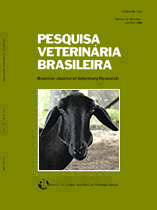 |
|
|
|
Year 2016 - Volume 36, Number 11
|

|
Study of fetal equine ovary: an histological approach, 36(11):1116-1120
|
ABSTRACT.- Moraes G.D., Curcio B. da R., Nogueira C.E., Pazinato F.M., Finger I.S., Silva A.C., Varella Jr. A.S. & Corcini C.D. 2016. [Study of fetal equine ovary: an histological approach.] Estudo de ovários fetais equinos: uma abordagem histológica. Pesquisa Veterinária Brasileira 36(11):1116-1120. Instituto de Ciências Biológicas, Universidade Federal do Rio Grande, Avenida Itália, km 8, Bairro Carreiros, Rio Grande, RS 96203-900, Brazil. E-mail: corcinicd@gmail.com
The study of embryological development of reproductive organs is an important tool for understanding the particularities of the equine species. Also it is important for increasing knowledge about the development of antral follicles that can be used for in vitro production of embryos. This study aimed to describe the morphological changes of fetal equine ovaries occurring during gestational development. It was used equine fetuses from a slaughterhouse. After slaughter, it was performed the measurement of cefalococcígea distance to calculate the gestational age (days of pregnancy - DP). Afterwards, the ovaries were grossly evaluated, removed and fixed. Then, they were histologically assessed by hematoxylin-eosin and PAS techniques. It was used 19 fetuses aged 50 to 269 days of gestation, distributed in 9 groups divided according to DP. In the grossly evaluation, it was observed differences between the volume of the ovaries according to gestational age, being observed bigger/larger ovarian volume between 210 days to 269 DP. During the histological evaluation, it was observed a simple cuboidal epithelium and a distinction between the cortical and medullary layers in fetal ovaries from 50-89 DP. The main characteristics identified were: the morphological distinction between the cortical and medullary layers in equine fetal ovaries; the ovigerous cords emerged in the interval between 150 and 179 DP; the cortex initiated as a thin layer with an increased amount of connective tissue rich in blood vessels by the 210 DP, structural uniformity acquired in the medular region by the 150 DP, showing similar cells in size and blood vessels of larger caliber. From this stage, the cells in this region had decreased in size and dense connective tissue bundles, which made this zone partially divided. |
| |
|
|
| |
|
 |